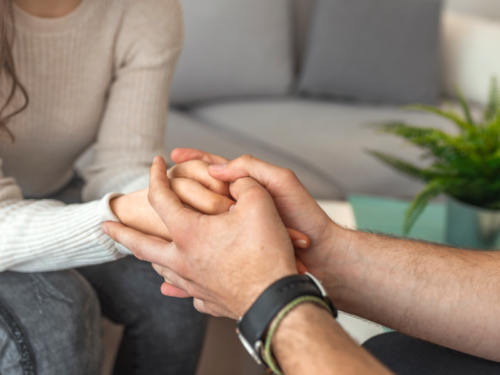
Table of Contents
How Common Is Sexual Assault? Look at These Statistics
Written By: Charlie Health Editorial Team
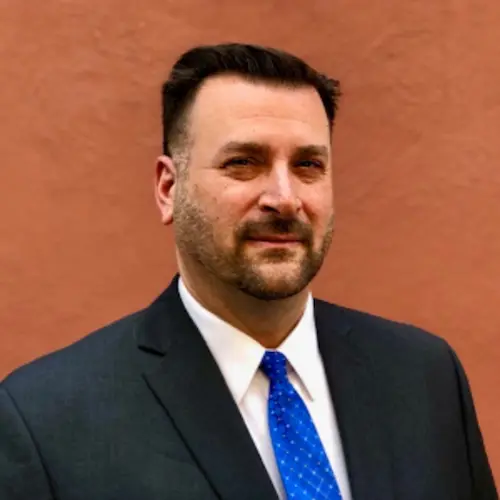
Clinically Reviewed By: Dr. Don Gasparini
Updated: March 29, 2024
6 min.
Sexual assault is an ever-growing problem. At Charlie Health, we believe education is prevention. Learn the facts below.
Learn more about our Clinical Review Process
Table of Contents
Sexual assault is alarmingly common worldwide, including in the United States, where data shows more than half of all women and nearly one-third of all men have endured sexual violence. Sexual assault includes any type of sexual contact or behavior that happens without consent, such as rape, attempted rape, forcing someone to perform sexual acts, and unwanted sexual contact.
In the U.S., children, teens, and adults are not exempt from sexual assault. Almost half of all rape survivors were first raped as minors, according to the Centers for Disease Control and Prevention (CDC). Sexual violence can happen to anyone, but some communities are most at risk — rates of sexual violence are disproportionately high among people of color and members of the LGBTQIA+ community.
Below, Charlie Health combed through the numbers, looking at sexual assault statistics by age, gender, and race, as well as data on the prevalence of sexual violence on college campuses. If you or a loved one have been affected by any kind of sexual violence, help is available. Call the National Sexual Assault Hotline at 1-800-656-4673 or chat online for confidential, 24/7 support. Remember: Sexual violence is never your fault, and you deserve help.

We support survivors
Intensive mental health support with others who get it.
Sexual assault statistics
Millions of people in the U.S. are impacted by sexual violence annually, and researchers know that the available data likely underrepresents the issue since many sexual assault cases go unreported.
Hundreds of thousands of people are raped annually
There are over 433,000 cases of sexual assault or rape annually in the U.S. among people ages 12 and older, according to The Rape, Abuse & Incest National Network (RAINN). Every 68 seconds, another American is sexually assaulted, RAINN data shows.
Sexual assault disproportionately affects women
People of all ages, genders, races, and ethnicities are affected by sexual assault. And, sexual violence is unfortunately common among both women and men — over half of women (53%) and nearly one-third of men (29%) report experiencing sexual violence, CDC data shows. On top of that, one-quarter of women and about one in 26 men have experienced completed or attempted rape, according to national data.
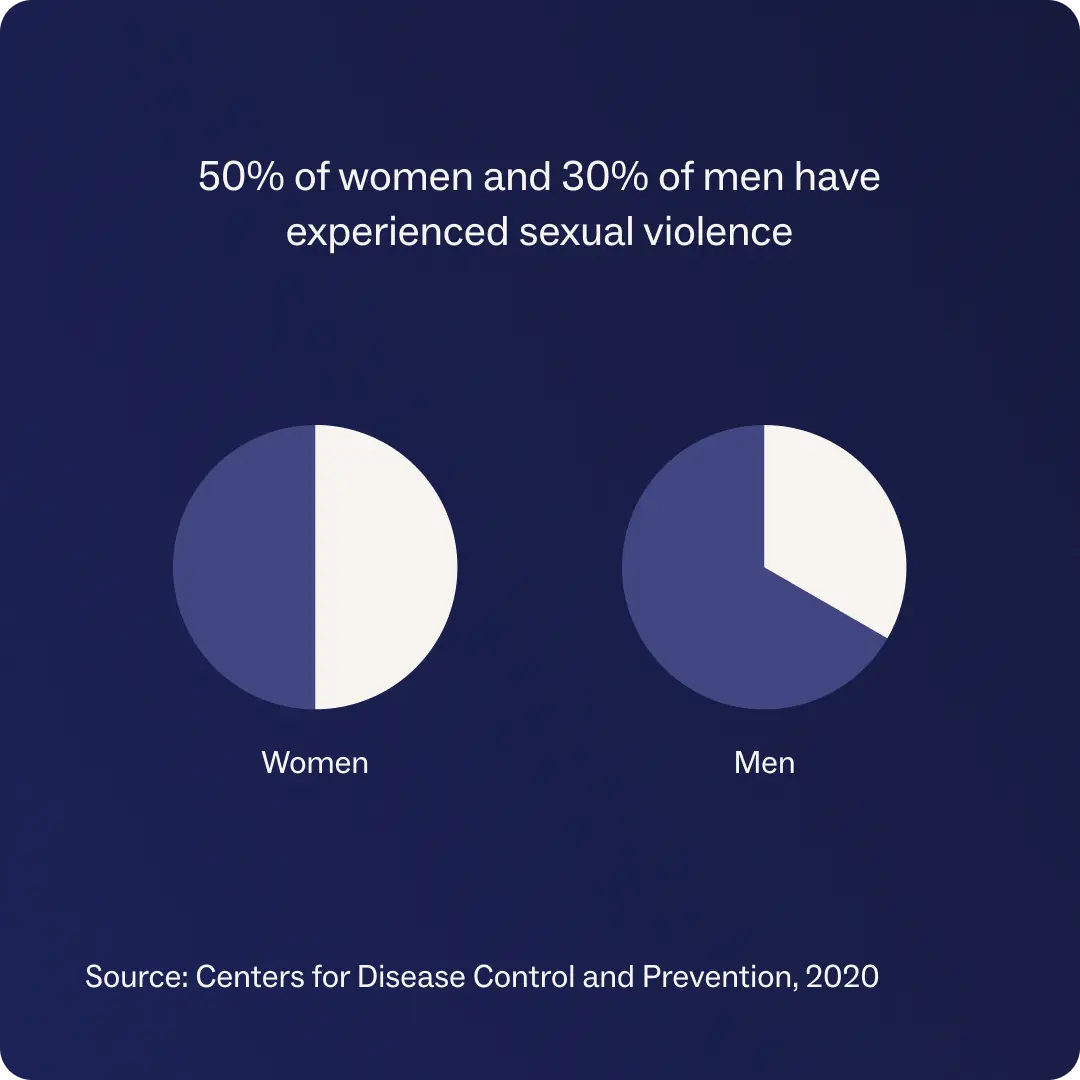
People of color and LGBTQIA+ people are at higher risk for sexual assault
The risk of sexual violence varies based on peoples’ age, gender, race, and ethnicity, with some communities being disproportionately at risk. For instance, Native Americans are at the greatest risk of sexual violence (twice as likely to experience rape or sexual assault compared to all races), according to RAINN.
Also, members of the LGBTQIA+ community are at higher risk of sexual violence. A 2021 study by the Williams Institute at UCLA School of Law found that transgender people are over four times more likely than cisgender people to experience violent victimization, including rape, sexual assault, and aggravated or simple assault. This study comes on the heels of another by the Williams Institute, which found that all LGBTQIA+ people are at higher risk of sexual violence than their non-LGBTQIA+ counterparts. Lesbian, bisexual, and transgender women are more than five times more likely than non-LBT women to experience violent victimization, and the risk of violence for gay, bisexual, and transgender men is more than twice of non-GBT men.
This data is intersectional, meaning that young women and trans women of color are disproportionately at risk of sexual assault.
Young people are also at higher risk for sexual assault — especially on campus
The highest risk years for sexual assault are between the ages of 12 and 34, data shows. This is particularly obvious on college campuses; campus sexual assault accounts for 43% of total on-campus crimes in the U.S., with approximately eight forcible sex offenses per 10,000 students, according to data analyzed by the American Psychological Association (APA). People of marginalized identities, including LGBTQIA+ students, those with disabilities, racial and ethnic minorities, international students, undocumented immigrants, and first-generation or low-income students, face elevated risks of college sexual assault, the data shows. By graduation, over one-quarter (26%) of female undergraduate students and almost 7% of undergraduate male students report experiencing sexual assault, according to a national 2020 study.
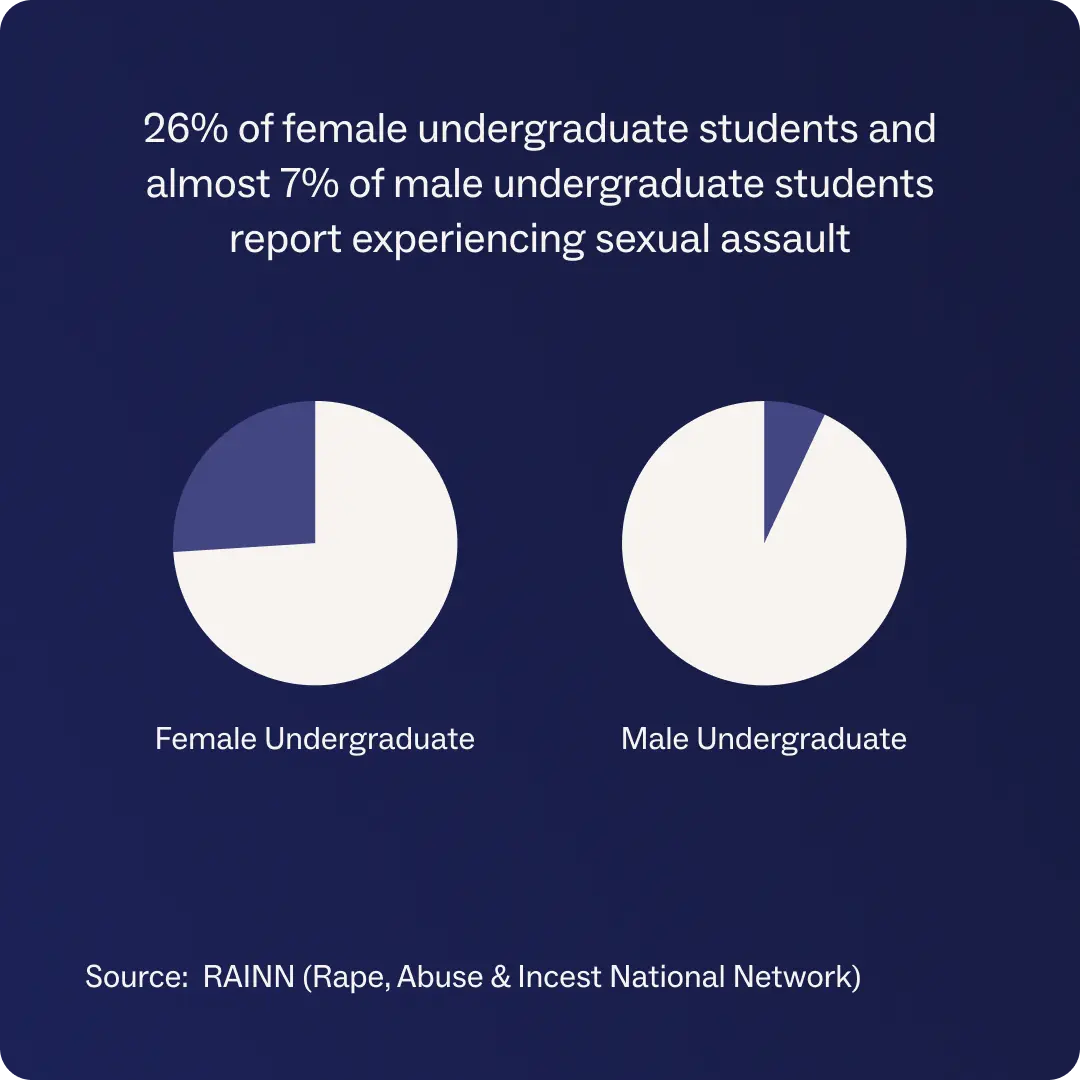
Rates of sexual violence are highest in Texas, California, and Florida
Texas, California, and Florida have the highest rates of forcible rape cases reported in the U.S. (13,509, 13,449, and 7,686, respectively), according to 2020 data from the FBI analyzed in a Statista data set. It’s worth noting that Texas and California have the highest population of states in the U.S., perhaps contributing to these rates — the rape rate (the number of rapes per 100,000 people) puts Alaska at the top of the list.
The majority of sexual assaults are not reported to police
According to the Department of Justice, only 310 out of every 1,000 sexual assaults are reported to the police. That means more than two out of three go unreported, with many survivors choosing not to report because they feared retaliation, believed the police would not do anything to help, or for other reasons. However, 98.8% of sexual abuse offenders were sentenced to prison, according to the United States Sentencing Commission.
Most survivors know the person who sexually assaulted them
Sexual assault by a stranger (sometimes referred to as “stranger rape”) is relatively uncommon. In fact, eight out of 10 victims know the person who raped them (sometimes known as “acquaintance rape”) — with perpetrators including acquaintances, family members, or a current or former romantic partner (the latter being a form of intimate partner violence, also known as domestic violence, partner abuse, or dating violence).
Sexual assault and mental health statistics
Survivors of sexual assault often experience a range of mental health challenges following sexual violence. These effects can be long-lasting and profoundly impact a survivor’s well-being and quality of life.
Most sexual assault victims develop mental health problems
Developing a mental health disorder after experiencing sexual assault is common. For instance, a study of teenage girls found that about 80% developed a mental health disorder — including depression, anxiety, and post-traumatic stress disorder (PTSD) — months after being sexually assaulted, underscoring the importance of understanding how to heal from sexual trauma, and over half (55%) developed two or more conditions.
Another study, which specifically looked at the long-term effects of sexual assault, found that childhood sexual abuse was associated with a wide range of negative outcomes, including conversion disorder, borderline personality disorder (BPD), anxiety, and depression. For many, this can lead to PTSD from childhood abuse that persists into adulthood.
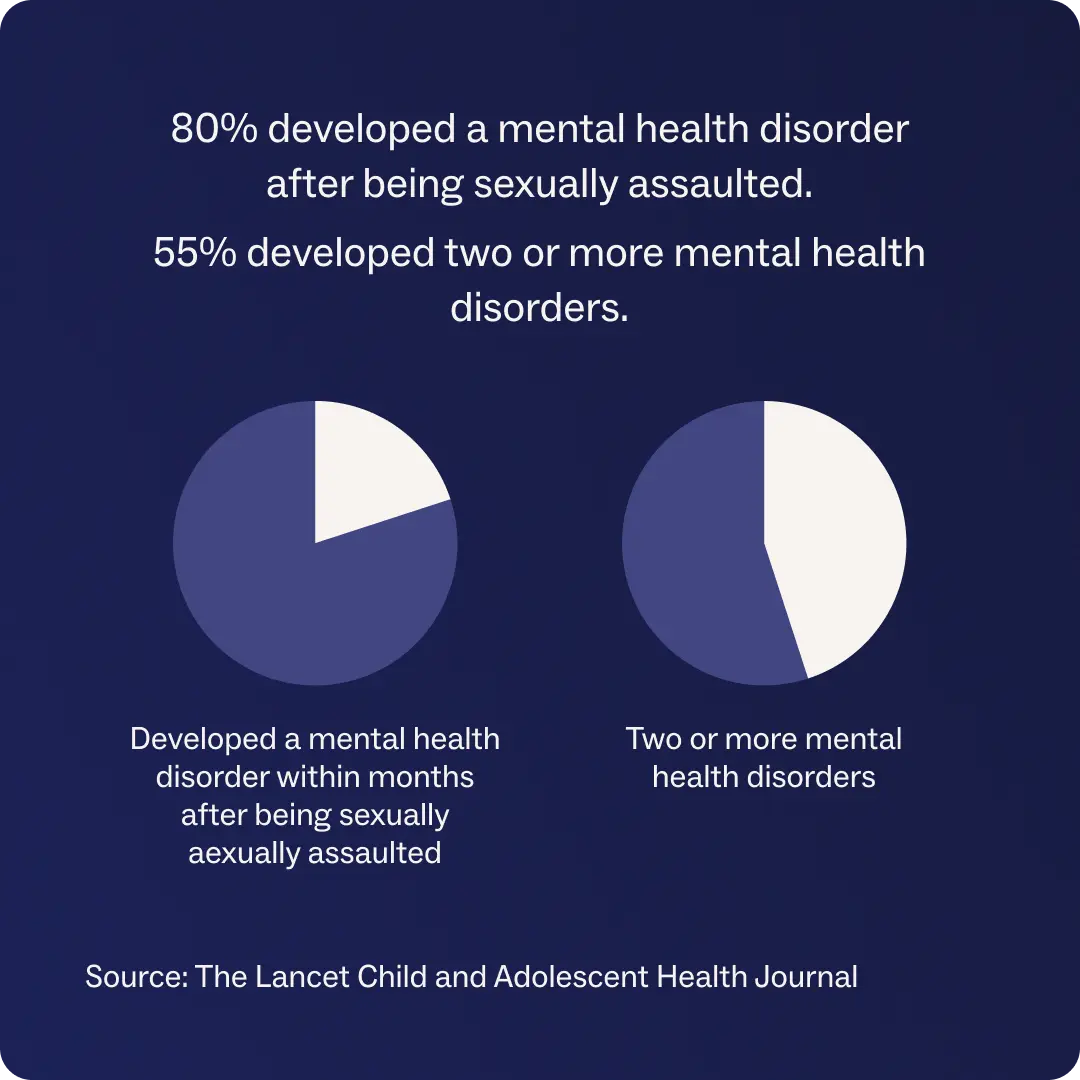
PTSD is particularly common among sexual assault survivors
In fact, PTSD symptoms manifest in nearly all female rape survivors in the two weeks following the rape, RAINN data shows. It’s important to distinguish between the experience of trauma vs. PTSD, as the latter is a specific clinical diagnosis. About one-third (30%) of female rape victims report symptoms of PTSD nine months after the rape, according to the same data. For survivors, especially teens, trauma-informed therapy can be particularly beneficial.
One-third of sexual assault victims contemplate suicide
According to data reported to RAINN, one-third (33%) of women who are raped contemplate suicide. This highlights the critical need to start conversations about suicide awareness and mental health, and about one in 10 women who are raped (13%) attempt suicide.
If you or a loved one are experiencing suicidal thoughts or are in danger of harming yourself, this is a mental health emergency. Contact The Suicide & Crisis Lifeline 24/7 by calling or texting 988.
Support for survivors at Charlie Health
If you or a loved one are struggling with mental health challenges following sexual violence, Charlie Health is here to help. Start healing with our virtual Intensive Outpatient Program, which combines group sessions with individual and family therapy for people and families dealing with various serious mental health struggles, including survivors of sexual assault. Our expert clinicians incorporate evidence-based therapies into individual counseling, family therapy, and group sessions. With this kind of holistic treatment, healing from sexual violence is possible. An important part of this journey can be learning to identify and cope with trauma triggers, for which resources like worksheets can be helpful.
Additional resources for survivors
- The National Domestic Violence Hotline
- The National Sexual Assault Hotline
- The National Child Abuse Hotline/Childhelp
- Safe Horizon
References
https://www.cdc.gov/sexual-violence/about/
https://www.rainn.org/statistics/scope-problem
https://www.rainn.org/statistics/victims-sexual-violence
https://williamsinstitute.law.ucla.edu/press/ncvs-trans-press-release/
https://williamsinstitute.law.ucla.edu/press/ncvs-lgbt-violence-press-release/
https://journals.sagepub.com/doi/full/10.1177/0886260520949149
https://www.apa.org/apags/resources/campus-sexual-assault-fact-sheet
https://www.statista.com/statistics/232524/forcible-rape-cases-in-the-us-by-state/
https://bjs.ojp.gov/library/publications/criminal-victimization-2020
https://www.rainn.org/statistics/perpetrators-sexual-violence
https://www.thelancet.com/journals/lanchi/article/PIIS2352-4642(18)30202-5/fulltext


